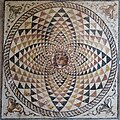User:Zde/AM of Corinth
Archaeological Museum of Ancient Corinth
Building and Lapidarium[edit]
| Object location | | View all coordinates using: OpenStreetMap |
|---|
http://odysseus.culture.gr/h/1/eh151.jsp?obj_id=3291
https://www.corinth-museum.gr/en/
-
Entrance
-
Exit
Lapidarium in corridors[edit]
Lapidarium in the courtyard[edit]
Neolithic[edit]
-
Neolithic pottery, 6000-3200 BC
Early and Middle Bronze Age[edit]
Early Helladic 3200-2000 BC, Middle Helladic 2000-1550 BC
-
Early Helladic pottery, 3200-2000 BC
-
Zygouries, 3250-2000 BC
-
Korakou, Early and Middle Helladic
-
Zygouries, 3250-1180 BC
-
200-1550 BC
Late Bronze Age[edit]
Late Helladic 1550-1050 BC, in Greece mostly Myceanean culture (Prehistoric Greece)
-
Findings from Korakou, LH II B, 1460–1400 BC
-
Zygouries
-
Zygouries
Mycenaean pottery[edit]
-
Collar-necked jar jar from Korakou
-
Ephyraean goblet from Korakou
-
Late Helladic bowl from Korakou.
-
From Zygouries, LH III B, 1300-1180 BC
-
Zygouries, LH III B, 1300-1180 BC
-
Zygouries, LH III B, 1300-1180 BC
-
Mycenaean crater, ca 1200 BC
Ancient Greek antiquities[edit]
Archaic sculpture[edit]
-
Sphinx, 575-550 BC
-
Lion of Korakou, 550-540 BC, originally 3.50 m high, with black and red paint
-
Lion of Korakou
-
Kouroi of Klenia, 530-520 BC
Classical and Hellenistic sculpture[edit]
Roman Age copies of Classical Greek sculpture[edit]
-
Persephone, Roman copy of 5th cent. BC original
-
Artemis
-
Aphrodite
-
Hermes or Perseus
-
Young Man
Pottery[edit]
-
Geometric amphora
-
800-750 BC
-
Krater, 560-540 BC, probably Corinthian
-
Oinochoe, 450-425 BC, probably Corinthian
-
From Athens, 550-530 BC
-
Attic(?) epinetron
-
probably late 6th c BC
-
Attic, 450 BC, Painter of London E 342
-
Aryballos
Corinthian pottery[edit]
Only pottery so explicitly described in the Museum
-
Corinthian geometric pottery
-
Early Proto-Corinthian pottery crater, 725-700 BC
-
690-650 BC (?)
-
650-610 BC (?)
-
Early Corinthian alabastron, 620-590 BC
-
Skyfos
-
Oinochoe, ca 600 BC
-
Middle corinthian fragment, 610-570 BC
-
Religious procession, 600-550 BC
-
Middle Corinthian, 590-570 BC
-
Middle Corinthian, 590-570 BC
-
Krater, 580-555 BC
-
6th to 4th century BC
-
Failed Corinthian skyfos
-
Colors
Krater from Poseidonia[edit]
Corinthian krater from Poseidonia, 6th century BC
Corinthian imitaion of the Attic pottery[edit]
-
White-ground lekythos
-
White-ground lekythos
-
red-figure kylix
Small terracottas[edit]
-
figurines and inscirbed sherds, 7th-3rd century BC
-
6th c. BC
-
7th-6th c. BC
-
Finds from Solygeia, 6th century BC
-
Women in circular dance, 6th c. BC
-
Figurine molds
Toys[edit]
-
Environment of children and women
-
Dolls
-
Dice, spinning tops
Votive terracottas[edit]
Votives for healings, 4th century BC
Metalware[edit]
Small bronzes[edit]
-
Horse, 8th century BC
-
Gryffin, 7th or 6th c BC
-
Mirror from Corinth, 6th c BC
-
Spout of Sacred Spring, 6th c BC
-
Inscribed Phiale from Poseidon temple of Isthmus
-
Amphora, 5th c BC
-
Kantharos, 5th century BC
Mirror from Poseidonia[edit]
5th century BC
Armament[edit]
(Iron)
-
Dagger, gold decoration, 825-800 BC
-
Corinthian helmet, 500-475 BC
Architectural elements and tools[edit]
-
Painted terracotta from temple of Apollo, 550 BC
-
Calendar 550-500 BC
-
Beds
-
Lyre, turtle shell
-
Flutes
-
Stele from the sacred spring in Corinth, with inscription
-
Weights with inscriptions, lead
Architectural elements in the external lapidary[edit]
Mostly columns and capitals in the Lapidarium behind the building. Sample of the capitals of different styles.
Roman Age[edit]
Roman Age sculpture[edit]
-
Athena Archegetis, 1st century AD, imitation of a Archaic type
-
Kore, archaizing style, 1st century AD
-
Head of Tyche, 1st cent. AD
-
Roman Emperor, with polychromy, 10-35 AD
-
Galba, 1st c. AD
-
Artemis or an Amazon, 2nd c. AD
-
Polydeukion, 140-150 AD
-
Herma of Herodes Atticus, 175-200 AD
-
Dionysos, 2nd century AD
-
Hermaic stele of Zeus
-
Archaistic female head, 2nd century AD
-
Emperor Caracalla, 211-217 AD
-
Asklepios, 3rd-4th c. AD
Sculptures from the Julian Basilica in the AM of Corinth[edit]
-
Emperor Augustus
-
Lucius Caesar
-
Gaius Caesar
-
Nero
-
Man in armor, 125-150 AD
Phrygian captives[edit]
Colossal statues of a Phrygian captive used as piers in the "Captive Facade" of the North Basilica, 160-220 AD
Roman Age sculpture in the Corridor[edit]
Archaistic base with reliefs[edit]
Inv. No. S-74-27, 1st cenury AD
Roman Age sculpture in the Lapidarium[edit]
Glassware[edit]
Mosaics[edit]
Pastoral scene[edit]
Floor of a Roman villa, 150-200 AD
From dining room[edit]
Discovered near Corinth which adorned the dining room of a luxurious Roman house, 2nd or early 3rd century AD
With a goat[edit]
Discovered near Corinth which adorned the the dining room of a luxurious Roman house, 2nd or early 3rd century AD
Dionysos[edit]
(A 609 / MOS 25-3), 150-300 AD
-
Dionysos, 150-300 AD
-
A 609 / MOS 25-3
Frescos[edit]
Wall Painting in the fresco technique on the stucco walls of a tomb near Corinth, 100-150 AD
Medieval art[edit]
In the Lapidarium in the courtyard
-
Byzantine relief
-
Latin relief








































































































































































































